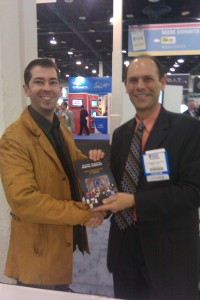As you’ve read from previous posts, I found DSE to be very rewarding. My top 5 moments:
1. Hard Rock Café Access – My first impressions from everything there were mixed – overwhelmed, underwhelmed (in a weird sort of way), giddy, and confused. Stepping away from it all, I’m able to digest all that I experienced there. No matter what, that Rock Wall really does rock. MS Surfaces are fun to play around with and I’m sure that if I were dining there, I would play with the booth touch screens to the point where it would probably be annoying. Truth be told, with all of the interactivity there, there might not be a better place for lovers of the 11th Screen world to go, including me. Interestingly enough, I just saw that these were featured in what I consider to be the gold standard in industry recognition – the new Communication Arts Interactive Annual (yet to be published online).
2. One-on-one discussions – the information and knowledge that I took away from the formal sessions paled in comparison to all of the one-on-one discussions I had. Guys at the Preset Group, Symon Communications, Reflect Systems, Muzak, Digital Signage Today, Daily DOOH, Arinc, and Daktronics – I enjoyed meeting you all and I look forward to continuing the conversation. We are all excited about the future of digital/interactive out of home.
3. The different & consistent perspectives of the future of DOOH – everyone talked about the future of digital out of home being bright. They also talked about the barriers we face – lack of consistency, measurement, and stories. There are many companies in the industry doing the same exact thing, but there are far too few stories and proven success. The industry, agencies, media planners/buyers, and clients need all three of these things – consistency, measurement standards, and stories.
4. The on-the-floor workshops – I attended Keith Kelsen’s and Gary Kayye’s small workshops and they were, hands down, the best formalized sessions offered at the show. Both are industry leaders and visionaries and I would recommend everyone hear them talk.
5. Mobile and social integration into digital signage – by extension, mobile and social integration into digital signage makes it interactive signage. I look at this as interactive out of home – 11th screen. I believe that this is the immediate future of DOOH. Content will always reign, and the better, more relevant the content is, the more people will be compelled to interact with it. But once you connect people through content, you have deeper engagement. And with deeper engagement, you strengthen relationships. With strong relationships, you have trust and with trust, you have loyalty and advocacy. I saw two companies integrating mobile & social – LocaModa (who you’ve probably all heard of, thanks to Jumbli) and Aerva (who I just heard of) – watch out for them both, especially Aerva. They have a great offering(s).
Again, none of this would have happened without the folks at DSE. They were really good to me and “thanks” on paper just doesn’t seem like it can capture my gratitude. I look forward to seeing them again.
How about you guys? What were your top moments of DSE?

